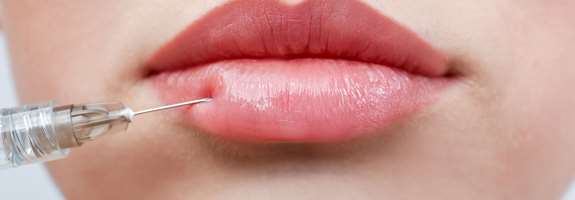Hyaluronic acid
Hyaluronic acid (HA), a molecule that is one of the components of the skin, gradually disappears with age. Its disappearance is the cause of facial sagging and the appearance of fine lines and wrinkles. It has been used since 1997 to fill in wrinkles and to improve the appearance of the skin in general. There are different types of hyaluronic acid with varying degrees of volumizing properties.
Depending on its cross-linking, HA can be used to hydrate the skin, treat more pronounced wrinkles or restructure volumes. The effect is immediate and improves after a few weeks. The result is maintained from 6 to 18 months depending on the HA injected and the patient's skin. In some cases, a touch-up can be performed 2 to 3 weeks after the injection. Several sessions may be necessary to achieve the desired effect. A follow-up treatment (one to three times a year) allows the degree of correction to be maintained for longer. The injections can be carried out regardless of the season.
Indications:
- definition of the oval of the face
- peribuccal wrinkles and fine lines ("bar code")
- chin projection
- non-surgical rhinoplasty
- filling of the frontal concavity
- filling of the temples
- filling of volumes lost with age due to bone resorption (cheekbones, temples, forehead)
- dark circles
- nasolabial folds
- bitterness folds, marionette lines, corners of the mouth
- non-surgical face lift
- non-surgical eyebrow lift, eyebrow elevation
- mandible (jaw) definition: widening, definition, lengthening
- peri-orbital concavity ("A-deformity convexity")
- volume, definition, hydration, natural lip eversion
- skin hydration (skin boosters), improvement of skin texture (neck, décolleté, face, hands...)
- etc...
Contraindications to injections:
- Notion of allergy: severe flare-ups (asthma, eczema) to any other severe allergic terrain.
- Sarcoidosis or granulomatous disease.
- Autoimmune diseases (lupus erythematosus, thyroid disease...)
- Immunosuppressive treatment (cortisone, ciclosporin, etc.).
- Interferon treatment (risk of granulomatous reactions).
- Injection of non-absorbable fillers (risk of granulomas).
- Pregnancy (or possibility of pregnancy) or if you are breastfeeding
Precautions before injections: Inform the dermatologist of:
- Coagulation or platelet disorders.
- Frequent herpes (preventive treatment to be taken).
- Name of product(s) previously injected
- Medical, surgical (including cosmetic), family and allergy history and any current medications (including vitamin supplements, phytotherapy, etc.)
- Anti-inflammatory drugs, vitamin C, and all supplements (omega 3, ginger, ginko biloba) must be stopped 3 days before the injections.
- Taking aspirin and anti-platelet agents will most likely be responsible for the formation of a hematoma. Taking anticoagulants is an absolute contraindication.
- Injections will only be possible after agreement from the cardiologist and replacement by a substitute treatment.
Precautions on the day of the injection:
- The injection should be postponed if you are ill or have recently been ill (cold, etc...), especially if you are taking anti-inflammatory medication.
- The injections are not very painful, but in some cases, a contact anesthetic (cream) or even a locoregional anesthetic (injections) can be used.
- In order to limit the risk of hematomas, the dermatologist may prescribe Arnica granules to be started 3 days before the injections and continued 2 days after.
- Taking alcohol before the injections increases the risk of hematoma.
Precautions to take after the injections:
- Avoid alcohol and anti-inflammatory drugs in the hours following the injections.
- Avoid moving the face for 3 hours.
- Make-up can be applied the next day. The dermatologist can recommend specific products to camouflage any hematomas.
- Avoid: sauna, sun exposure, violent sports, dental care, skin cleaning for 3 days.
Results
The results will be visible immediately after the session, but the final appearance (more or less water ingress depending on the indication) will be visible after two weeks.
What are the side effects?
- Frequently: slight swelling, redness, discomfort, or sensitivity at the injection site disappear in 1 to 2 days (one week for lip injections). Any hematomas appear within 48 hours and persist for about eight days (variable depending on the patient) but can be camouflaged by make-up.
- Unusual: itching, discoloration.
- Very rarely : (1 in 2000 patients) localized hypersensitivity reactions: swelling at the site of implantation extending to surrounding tissue.
- Exceptional: unknown reactions inherent to any medical procedure



